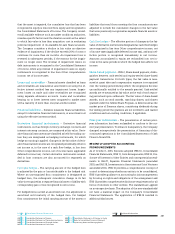Siemens 2014 Annual Report Download - page 255
Download and view the complete annual report
Please find page 255 of the 2014 Siemens annual report below. You can navigate through the pages in the report by either clicking on the pages listed below, or by using the keyword search tool below to find specific information within the annual report.
247 D. Consolidated Financial Statements 337 E. Additional Information
248 D. Consolidated Statements of Income
249 D. Consolidated Statements of Comprehensive Income
250 D. Consolidated Statements of Financial Position
251 D. Consolidated Statements of Cash Flows
252 D. Consolidated Statements of Changes in Equity
254 D. Notes to Consolidated Financial Statements
330 D. Supervisory Board and Managing Board
through direct or indirect ownership of % to % of the vot-
ing rights). These are recorded in the Consolidated Financial
Statements using the equity method and are initially recog-
nized at cost. When Siemens holds less than % of the voting
power of the investee, other facts and circumstances may
result in the Company exercising significant influence. Joint
arrangements are arrangements over which Siemens and one
or more parties have joint control. Joint control is the contrac-
tually agreed sharing of control that exists only when decisions
about the relevant activities require the unanimous consent of
the parties sharing control. Joint arrangements that are struc-
tured through a separate vehicle are classified as joint ventures
if the parties to the arrangement have rights to its net assets.
Joint ventures are accounted for using the equity method
and are initially recognized at cost. The equity method is
applied from the date when Siemens obtains significant influ-
ence or joint control, and is discontinued from the date when
Siemens ceases to have significant influence or joint control
over an investee.
The following policies equally apply to associates and joint ven-
tures. Where necessary, adjustments are made to bring the
accounting policies in line with those of Siemens. The excess
of Siemens’ initial investment in associates over Siemens’ own-
ership percentage in the underlying net assets of those compa-
nies is attributed to certain fair value adjustments with the
remaining portion recognized as goodwill. Goodwill relating to
the acquisition of associates is included in the carrying amount
of the investment and is not amortized but is tested for impair-
ment as part of the overall investment in the associate.
Siemens’ share of its associate’s post-acquisition profits or
losses is recognized in the Consolidated Statements of Income,
and its share of post-acquisition movements in equity that
have not been recognized in the associate’s profit or loss is rec-
ognized directly in equity. The cumulative post-acquisition
movements are adjusted against the carrying amount of the
investment in the associate. When Siemens’ share of losses in
an associate equals or exceeds its interest in the associate,
Siemens does not recognize further losses, unless it incurs
obligations or makes payments on behalf of the associate. The
interest in an associate is the carrying amount of the invest-
ment in the associate together with any long-term interests
that, in substance, form part of Siemens’ net investment in the
associate. Intercompany results arising from transactions be-
tween Siemens and its associates are eliminated to the extent
of Siemens’ interest in the associate. Siemens determines at
each reporting date whether there is any objective evidence
that the investment in the associate is impaired. If this is the
case, Siemens calculates the amount of impairment as the
difference between the recoverable amount of the associate
and its carrying value. Upon loss of significant influence over
the associate or joint control over the joint venture, Siemens
measures and recognizes any retaining investment at its fair
value. Any difference between the carrying amount of the as-
sociate or joint venture upon loss of significant influence or
joint control and the fair value of the retaining investment and
proceeds from disposal is recognized in profit or loss.
Joint operations – A joint operation is a jointly controlled
arrange ment whereby the parties have rights to the assets and
obligations for the liabilities relating to the arrangement.
Siemens as joint operator recognizes in relation to its interest
in the joint operation the assets and liabilities controlled by
Siemens, its share of any jointly held assets or jointly incurred
liabilities and revenues from the sale of its output and any
related expenses including its share in revenues and expenses
incurred jointly, in relation to the joint operation.
Foreign currency translation
– The assets, including good-
will, and liabilities of foreign subsidiaries, where the functional
currency is other than the euro, are translated using the spot
exchange rate at the end of the reporting period, while the
Consolidated Statements of Income are translated using aver-
age exchange rates during the period. Differences arising from
such translations are recognized within equity and reclassified
to net income when the gain or loss on disposal of the foreign
subsidiary is recognized. The Consolidated Statements of Cash
Flow are translated at average exchange rates during the
period, whereas cash and cash equivalents are translated at the
spot exchange rate at the end of the reporting period.
The exchange rate of the U.S. dollar, Siemens’ significant cur-
rency outside the euro zone used in the preparation of the
Consolidated Financial Statements is as follows:
Year-end exchange
rate € quoted into
Annual average
rate € quoted into
currencies
specified below
currencies
specified below
September ,
Year ended
September ,
Currency ISO Code
U.S. dollar USD 1.258 1.351 1.357 1.313
Foreign currency transaction – Transactions that are
denominated in a currency other than the functional currency
of an entity, are recorded at that functional currency applying
the spot exchange rate at the date when the underlying trans-
actions are initially recognized. At the end of the reporting
period, foreign currency-denominated monetary assets and lia-
bilities are revalued to functional currency applying the spot
exchange rate prevailing at that date. Gains and losses arising
























